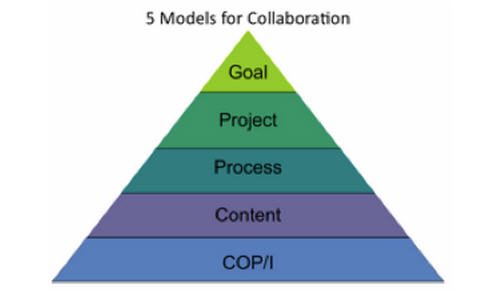Collaboration is not new to business, but the recent advent of Web 2.0 and Enterprise 2.0 tools and technologies have changed the collaborative abilities and scale of distributed collaboration for the enterprise. Whether it’s because the “World is Flat” or you want to tap the “Wisdom of Crowds,” collaboration, we are told should be a part of your business strategy.
What Collaboration is Not
But, collaboration is more than a word or even an idea. Many individuals speak of collaboration as if it is a single business process or approach to communication and networking. Much of this attitude stems from the popularized viral adoption of social computing Web 2.0 tools. This is not the case for Enterprise 2.0, the application of collaborative tools within the firewall.
Recently, Democrasoft president, Richard Lang blogged,
“despite best intentions and the best product, an online community will only be successful if there is a motivated person (the Moderator) who is committed to making it successful, on a day-to-day basis”.
Some background: Democrasoft is an “easy to deploy” online collaboration tool. Early history with the product saw hundreds of communities using the platform. But, activity plummeted shortly thereafter, not because the tool didn’t work or meet user demands, but simply because -- as Democrasoft found out the hard way, communities need a mission or purpose and a leader. Technology alone is not enough.
Indeed, if web-based collaboration were only about technology, then any organization with even a modest IT budget would be doing it, and doing it well. But this is not the case. Tools to facilitate collaboration are valuable, but they do not obsolesce the need for strategy. Collaboration needs to be deliberately designed and managed in order to maximize effectiveness and the value of the outcome.
If this sounds daunting -- you are right. But there are ways to put a framework around your assessment. Begin with your definition of collaboration and community and the specific business goals or objectives desired from collaboration.
The 5 Collaboration Models
As you define the goals and objectives, translate these into a basic collaboration model or platform. There are 5, as illustrated in the pyramid below. These models are inclusive, that is to say that the models higher on the pyramid embrace the needs and characteristics of those below it. Typically this also means that the models higher up on the pyramid occur at a lesser rate than those below it.

Communities of Practice/Interest
Communities of Practice and Interest (COP/I) are social platforms that allow members of a community to share ideas and discussion. They are focused on a particular issue or topic, and provide interpersonal knowledge exchange.
Content Collaboration
Content collaboration is basically a library. Participants post relevant content, and thus collaboratively build the library over time. This can also include the collaborative authoring of new content.
Process Collaboration
Process collaboration brings the community together through a business process. Individuals collaborate based on tasks in a coordinated series of orchestrated tasks. The goal is typically process efficiency and control, including identification of the right team member at the right time.
Project Collaboration
Project collaboration has a defined purpose, a start and end date and clearly defined parameters.
Goal-based Collaboration
Goal-based collaboration involve projects that have well defined specifically articulated outcomes or questions to be answered. The end date is basically determined by the achievement of the goal.
The collaboration model(s) you identify should be supported by a technology framework that leverages specific features from specific tools including automated work scheduling and groupware, mashups, blogs, wikis and social networking.
Don't Forget Community Dynamics
Finally, pay careful attention to the dynamics of the targeted community or you can jeopardize the success of your effort, in spite of any other planning you have done.
An organization I worked with did not heed this warning. After under going an intensive assessment it was recommended that corporate culture be addressed first and foremost, as it was contradictory to open and transparent collaboration. When this was pointed out, management took it "under advisement". They went ahead and funded an elaborate technology approach to expertise location and collaboration. The project died, and blame was placed on the technology.
This occurred nearly 10 years ago. Will we ever learn? We place new labels on the issue (it's not KM anymore, now its collaboration); new products emerge (SharePoint: "it does everything"), and all too often forget the lessons of the past. We believe that the "new focus" and/or the new technology will deliver on the promise without requiring any strategy.
Read more on Enterprise Collaboration, including: Architecting Participation with Enterprise Social Media by Brice Dunwoodie
